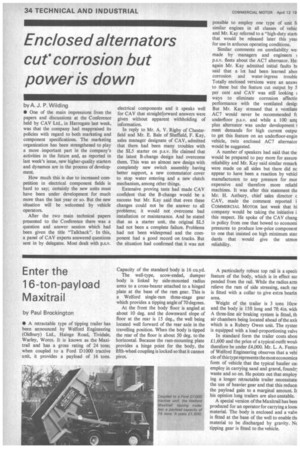Enclosed alternators cur corrosion but power is down
Page 36

If you've noticed an error in this article please click here to report it so we can fix it.
by A. J. P. Wilding • One of the main impressions from the papers and discussions at the Conference held by CAV Ltd., in Harrogate last week, was that the company had reappraised its policies with regard to both marketing and component specifications. The marketing organization has been strengthened to play a more important part in the company's activities in the future and, as reported in last week's issue, new higher-quality starters and dynamos are in the process of development.
How much this is due to increased competition in electrical component fields is hard to say; certainly the new units must have been under development for much more than the last year or so. But the new situation will be welcomed by vehicle operators.
After the two main technical papers presented to the Conference there was a question and answer session which had been given the title "Talkback". In this, a panel of CAV experts answered questions sent in by delegates. Most dealt with p.s.v. electrical components and it speaks well for CAV that straightforward answers were given without apparent withholding of information.
In reply to Mr. A. V. Rigby of Chesterfield and Mr. E. Bale of Sheffield, F. Kay, sales manager designate of CAV, admitted that there had been many troubles with the SL5 starter on p.s.v. He claimed that the latest B-change design had overcome them. This was an almost new design with completely new switch assembly having better support, a new commutator cover to stop water entering and a new clutch mechanism, among other things.
Extensive proving tests had made CAV confident that the B-change would be a success but Mr. Kay said that even these changes could not be the answer to all problems; it would not overcome bad installation or maintenance. And he stated that as a starter unit, the original SL5 had not been a complete failure. Problems had not been widespread and the component had a good record on trucks. But the situation had confirmed that it was not
possible to employ one type of unit fi similar engines in all classes of vehic and Mr. Kay referred to a "high-duty start that would be released later this year for use in arduous operating conditions.
Similar comments on unreliability we: made by managers and engineers ( p.s.v. fleets about the AC7 alternator. He: again Mr. Kay admitted initial faults hi said that a lot had been learned abot corrosion and water-ingress trouble Totally enclosed versions were an answe to these but the feature cut output by 5 per cent and CAV was still looking ways to eliminate corrosion affectin performance with the ventilated desigi But Mr. Kay stressed that a ventilate AC7 would never be recommended fi underfloor p.s.v. and while a 100 amr plus alternator was under development I meet demands for high current outpu; to get this feature on an underfloor-engin vehicle, twin enclosed AC7 alternator would be suggested.
A number of speakers had said that the would be prepared to pay more for assure, reliability and Mr. Kay said similar remark were made on all sides but there did nc appear to have been a reaction by vehicl manufacturers to any pressure for mor expensive and therefore more reliabl machines. It was after this statement tha Mr. H. Astbury, chief sales director c CAV, made the comment reported i COMMERCIAL MOTOR last week that hi company would be taking the initiative i this respect. He spoke of the CAV chang in policy from one that bowed to economi pressures to produce low-price component to one that insisted on high minimum star dards that would give the utmos reliability.




































































































